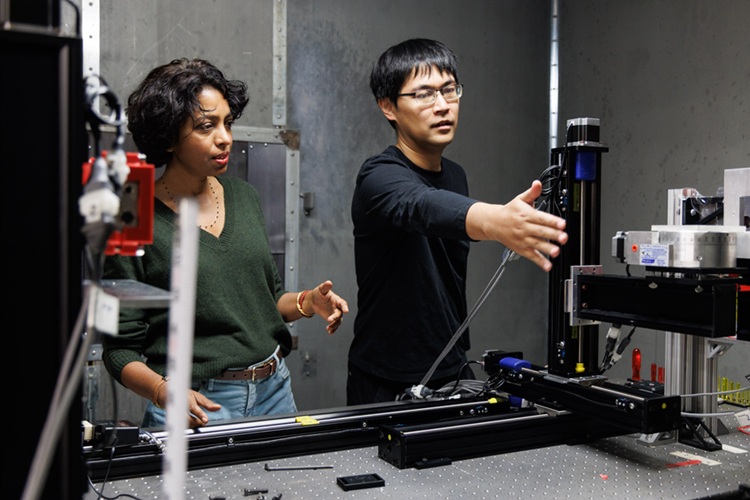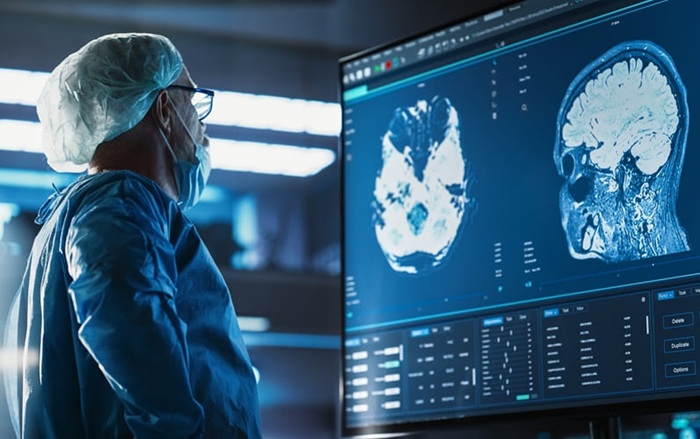Functional Imaging Technique Measures Brain Resting State
|
By MedImaging International staff writers Posted on 18 Jan 2016 |
A new study suggests that functional magnetic resonance imaging (fMRI) could be a cost-effective alternative for estimating relative levels of activity in a cerebral metabolic map.
Researchers at Western University (WU; London, Canada) and the University Hospital of Liège (Belgium) conducted a study to gauge the possibility of using fMRI instead of 18F-fluorodeoxyglucose positron emission tomography (FDG-PET) for generating the metabolic maps that are used to asses changes in brain activity in clinical applications, such as during the study of severe brain injury and disorders of consciousness.
To do so, the researchers first extracted resting state fMRI functional connectivity maps using independent component analysis, and combined only components of neuronal origin. They then compared the generated maps with the FDG-PET maps in 16 healthy controls, 11 vegetative state/unresponsive wakefulness syndrome patients, and in four locked-in patients.
The results showed a significant similarity for healthy controls and for vegetative state/unresponsive wakefulness syndrome patients between the FDG-PET and the fMRI based maps, with conjunction analysis showing decreased frontoparietal and medial regions in vegetative patients with respect to controls. Subsequent analysis in locked-in syndrome patients, which are known to be conscious, also produced consistent neuronal maps with healthy controls. The study was published on December 29, 2015, in Brain and Behavior.
“Many hospitals in developing countries have access to functional MRI technology or FDG-PET, but not both. By developing new fMRI techniques, hospitals that already have the expensive scanning equipment or wish to purchase a unit effectively get 'more bang for their buck’,” said lead author Andrea Soddu, PhD, of the WU department of physics and astronomy. “If no metabolic absolute measures can be extracted, our approach may still be of clinical use in centers without access to FDG-PET.”
PET scans are widely used to diagnose and track a variety of diseases, including cancer, because they show how organs and tissues function in the body, in contrast to MRI or CT scans, which mostly show anatomy. Using radioactive tracers that produce a signal from within the body, PET scanners produce a 3D image that is constructed by computers using sophisticated mathematical techniques.
Related Links:
Western University
University Hospital of Liège
Researchers at Western University (WU; London, Canada) and the University Hospital of Liège (Belgium) conducted a study to gauge the possibility of using fMRI instead of 18F-fluorodeoxyglucose positron emission tomography (FDG-PET) for generating the metabolic maps that are used to asses changes in brain activity in clinical applications, such as during the study of severe brain injury and disorders of consciousness.
To do so, the researchers first extracted resting state fMRI functional connectivity maps using independent component analysis, and combined only components of neuronal origin. They then compared the generated maps with the FDG-PET maps in 16 healthy controls, 11 vegetative state/unresponsive wakefulness syndrome patients, and in four locked-in patients.
The results showed a significant similarity for healthy controls and for vegetative state/unresponsive wakefulness syndrome patients between the FDG-PET and the fMRI based maps, with conjunction analysis showing decreased frontoparietal and medial regions in vegetative patients with respect to controls. Subsequent analysis in locked-in syndrome patients, which are known to be conscious, also produced consistent neuronal maps with healthy controls. The study was published on December 29, 2015, in Brain and Behavior.
“Many hospitals in developing countries have access to functional MRI technology or FDG-PET, but not both. By developing new fMRI techniques, hospitals that already have the expensive scanning equipment or wish to purchase a unit effectively get 'more bang for their buck’,” said lead author Andrea Soddu, PhD, of the WU department of physics and astronomy. “If no metabolic absolute measures can be extracted, our approach may still be of clinical use in centers without access to FDG-PET.”
PET scans are widely used to diagnose and track a variety of diseases, including cancer, because they show how organs and tissues function in the body, in contrast to MRI or CT scans, which mostly show anatomy. Using radioactive tracers that produce a signal from within the body, PET scanners produce a 3D image that is constructed by computers using sophisticated mathematical techniques.
Related Links:
Western University
University Hospital of Liège
Latest MRI News
- Novel Imaging Approach to Improve Treatment for Spinal Cord Injuries
- AI-Assisted Model Enhances MRI Heart Scans
- AI Model Outperforms Doctors at Identifying Patients Most At-Risk of Cardiac Arrest
- New MRI Technique Reveals Hidden Heart Issues
- Shorter MRI Exam Effectively Detects Cancer in Dense Breasts
- MRI to Replace Painful Spinal Tap for Faster MS Diagnosis
- MRI Scans Can Identify Cardiovascular Disease Ten Years in Advance
- Simple Brain Scan Diagnoses Parkinson's Disease Years Before It Becomes Untreatable
- Cutting-Edge MRI Technology to Revolutionize Diagnosis of Common Heart Problem
- New MRI Technique Reveals True Heart Age to Prevent Attacks and Strokes
- AI Tool Predicts Relapse of Pediatric Brain Cancer from Brain MRI Scans
- AI Tool Tracks Effectiveness of Multiple Sclerosis Treatments Using Brain MRI Scans
- Ultra-Powerful MRI Scans Enable Life-Changing Surgery in Treatment-Resistant Epileptic Patients
- AI-Powered MRI Technology Improves Parkinson’s Diagnoses
- Biparametric MRI Combined with AI Enhances Detection of Clinically Significant Prostate Cancer
- First-Of-Its-Kind AI-Driven Brain Imaging Platform to Better Guide Stroke Treatment Options
Channels
Radiography
view channel
X-Ray Breakthrough Captures Three Image-Contrast Types in Single Shot
Detecting early-stage cancer or subtle changes deep inside tissues has long challenged conventional X-ray systems, which rely only on how structures absorb radiation. This limitation keeps many microstructural... Read more
AI Generates Future Knee X-Rays to Predict Osteoarthritis Progression Risk
Osteoarthritis, a degenerative joint disease affecting over 500 million people worldwide, is the leading cause of disability among older adults. Current diagnostic tools allow doctors to assess damage... Read moreUltrasound
view channel
Wearable Ultrasound Imaging System to Enable Real-Time Disease Monitoring
Chronic conditions such as hypertension and heart failure require close monitoring, yet today’s ultrasound imaging is largely confined to hospitals and short, episodic scans. This reactive model limits... Read more
Ultrasound Technique Visualizes Deep Blood Vessels in 3D Without Contrast Agents
Producing clear 3D images of deep blood vessels has long been difficult without relying on contrast agents, CT scans, or MRI. Standard ultrasound typically provides only 2D cross-sections, limiting clinicians’... Read moreNuclear Medicine
view channel
PET Imaging of Inflammation Predicts Recovery and Guides Therapy After Heart Attack
Acute myocardial infarction can trigger lasting heart damage, yet clinicians still lack reliable tools to identify which patients will regain function and which may develop heart failure.... Read more
Radiotheranostic Approach Detects, Kills and Reprograms Aggressive Cancers
Aggressive cancers such as osteosarcoma and glioblastoma often resist standard therapies, thrive in hostile tumor environments, and recur despite surgery, radiation, or chemotherapy. These tumors also... Read more
New Imaging Solution Improves Survival for Patients with Recurring Prostate Cancer
Detecting recurrent prostate cancer remains one of the most difficult challenges in oncology, as standard imaging methods such as bone scans and CT scans often fail to accurately locate small or early-stage tumors.... Read moreGeneral/Advanced Imaging
view channel
New Algorithm Dramatically Speeds Up Stroke Detection Scans
When patients arrive at emergency rooms with stroke symptoms, clinicians must rapidly determine whether the cause is a blood clot or a brain bleed, as treatment decisions depend on this distinction.... Read more
3D Scanning Approach Enables Ultra-Precise Brain Surgery
Precise navigation is critical in neurosurgery, yet even small alignment errors can affect outcomes when operating deep within the brain. A new 3D surface-scanning approach now provides a radiation-free... Read moreImaging IT
view channel
New Google Cloud Medical Imaging Suite Makes Imaging Healthcare Data More Accessible
Medical imaging is a critical tool used to diagnose patients, and there are billions of medical images scanned globally each year. Imaging data accounts for about 90% of all healthcare data1 and, until... Read more
Global AI in Medical Diagnostics Market to Be Driven by Demand for Image Recognition in Radiology
The global artificial intelligence (AI) in medical diagnostics market is expanding with early disease detection being one of its key applications and image recognition becoming a compelling consumer proposition... Read moreIndustry News
view channel
GE HealthCare and NVIDIA Collaboration to Reimagine Diagnostic Imaging
GE HealthCare (Chicago, IL, USA) has entered into a collaboration with NVIDIA (Santa Clara, CA, USA), expanding the existing relationship between the two companies to focus on pioneering innovation in... Read more
Patient-Specific 3D-Printed Phantoms Transform CT Imaging
New research has highlighted how anatomically precise, patient-specific 3D-printed phantoms are proving to be scalable, cost-effective, and efficient tools in the development of new CT scan algorithms... Read more
Siemens and Sectra Collaborate on Enhancing Radiology Workflows
Siemens Healthineers (Forchheim, Germany) and Sectra (Linköping, Sweden) have entered into a collaboration aimed at enhancing radiologists' diagnostic capabilities and, in turn, improving patient care... Read more




















